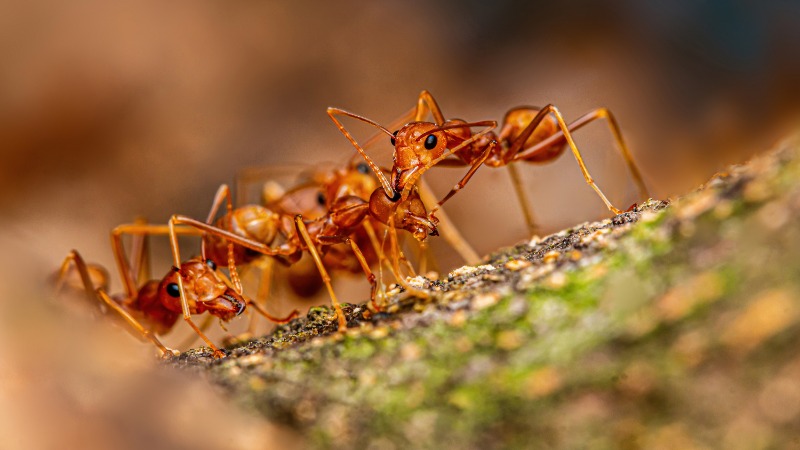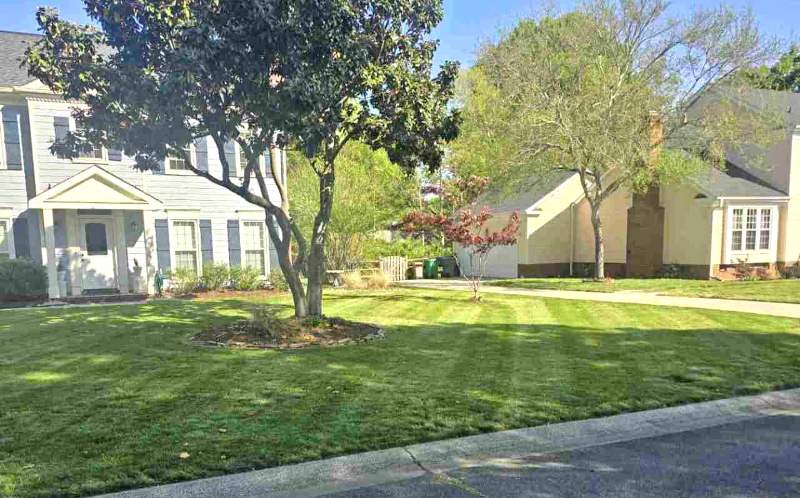
Charlotte neighborhoods shine in spring. From South End to University City, a well-timed lawn care plan now means greener, fuller grass all year.
The most successful yards here follow a plan tailored to our transition-zone climate and dominant grass types. Timing is everything – whether you have a cool-season Tall Fescue lawn that wakes in March or a warm-season Bermuda lawn, you need to know exactly when your yard is ready to be mowed, fed, weeded, and repaired.
Local factors like our clay-heavy soil, mild winters, and the risk of summer brown patch all shape the best approach.
Here’s an eight-step spring lawn care plan tailored to Charlotte’s climate and grass types. Use it as a seasonal guide to keep your yard healthy, green, and ready for summer.
1. Clean Winter Debris
Start your spring with a clean slate. Rake away leaves, sticks, and other debris that have collected over the winter. This prevents dead matter from smothering new growth and other potentially harmful issues from developing. It also makes it easier to mow and treat your lawn in the coming weeks.
- Tall Fescue/Kentucky Bluegrass: Clear debris to prevent moisture-related diseases such as brown patch and snow mold.
- Bermuda/Zoysia: Remove debris to allow more sunlight and help your warm-season lawn green up faster.
- Pro tip: Rake only when the grass is dry to avoid pulling up healthy turf.
See Related: How to Rake Leaves
2. Mow at the Right Time
In Charlotte, the first mow of the season is usually mid- to late March for cool-season Tall Fescue, and early April for warm-season Bermuda and Zoysia. Wait until the grass is actively growing—about 3 inches for Fescue and Kentucky Bluegrass mixes, or close to its recommended mowing height for Bermuda and Zoysia—to preserve its growing power and resiliency after mowing.
- Tall Fescue/Kentucky Bluegrass: Keep at 3 to 3.5 inches; never cut more than one-third of the blade.
- Bermuda/Zoysia: Keep 1 to 2 inches for a clean, dense look
- Pro tips: Sharpen your mower blades before the first mow to prevent tearing the grass. Bag clippings from the first cut to remove lingering debris.
See Related: When is the Best Time to Mow Your Grass
3. Stop Weeds Before They Start

Charlotte lawns see a surge of crabgrass, spurge, and other summer weeds in spring. Apply a pre-emergent herbicide in late winter or early March, when soil temps (not air temps) hit about 50–55 °F for several days.
- If seeding: Skip pre-emergent, as it will block new grass seed from germinating.
- Post-emergent control: Spot-treat any existing weeds before they spread.
- Pro tip: Use a soil thermometer to check ground temperature before applying pre-emergent.
See Related:
4. Fertilize for the Grass Type You Have

Feeding your lawn at the right time keeps it healthy and resilient, but in Charlotte, the ideal fertilization window depends on the type of grass you grow. Soil test results are also a key factor in guiding your fertilizer decisions.
- Tall Fescue/Kentucky Bluegrass: Light feeding in late March or April after growth resumes. Avoid heavy nitrogen to reduce summer brown patch risk.
- Bermuda/Zoysia: Fertilize only after full green-up, usually late April or May.
- Pro tip: Use slow-release nitrogen and follow soil test results for nutrient balance.
See Related: How to Fertilize Your North Carolina Lawn
5. Aerate Compacted Soil

Charlotte’s clay soil compacts easily, limiting water and nutrient flow. Aerate if you notice thin growth or hard soil. Choose core aeration over spike aeration for the best results across all grass types.
- Tall Fescue/Kentucky Bluegrass: Best aerated in fall, but can be done in early spring if needed for compaction relief.
- Bermuda/Zoysia: Aerate in late spring (May) when growth is vigorous.
- Pro tip: Mark sprinkler heads and shallow lines before aerating.
See Related:
6. Repair Bare Spots and Overseed if Needed
Overseed or repair bare spots early to create a uniform green lawn, block weeds from gaining a foothold, and maintain both the curb appeal and long-term health of your turf. Early effort here goes a long way come summer.
- Tall Fescue/Kentucky Bluegrass: Fall is optimal, but light spring overseeding can patch problem areas.
- Bermuda/Zoysia: Seed or sod in late spring for strong summer establishment.
- Pro tip: Keep soil moist until new grass is established.
See Related:
7. Water Wisely
Charlotte’s spring rains usually bring enough water to reduce the need for supplemental watering. That said, always be ready to irrigate during dry spells. Aim for about 1 inch of total water per week (rain plus irrigation), applied deeply and infrequently. Water early in the morning to reduce evaporation and disease risk. Avoid overwatering, which can lead to shallow roots, increase disease risk, and waste water.
- Tall Fescue/Kentucky Bluegrass: Needs steadier moisture in spring to stay healthy heading into summer. Monitor closely and water when the top inch of soil begins to dry.
- Bermuda/Zoysia: More drought-tolerant once established, may need less supplemental water until fully greened up.
- Pro tip: For best root growth, water deeply and infrequently, allowing moisture to penetrate 6 inches into the soil.
See Related: How Long Should I Water My Lawn?
8. Watch for Early Pest and Disease Signs

Grubs, fire ants, and fungal diseases can start early in our warm, humid climate. Apply grub control in mid- to late spring if you’ve had past problems. Address fire ant mounds promptly.
- Tall Fescue/Kentucky Bluegrass: Consider a preventive fungicide in late spring to reduce the risk of brown patch. Avoid excessive nitrogen fertilizer.
- Bermuda/Zoysia: Watch for spring dead spot. Treat with a labeled fungicide and maintain proper mowing height and fertility to limit stress.
- Pro tip: Walk your lawn at least once a week in spring—early detection of trouble spots is the easiest way to keep pests and disease from spreading.
See Related: 5 Worst Lawn Pests in Charlotte
Hire a Lawn Care Pro in Charlotte

Spring lawn care takes time, tools, and a solid understanding of Charlotte’s climate. If you’d rather enjoy the season without the weekend yard work, hire a local LawnStarter pro.
We work with trusted lawn care crews across the metro area, including Concord, Gastonia, Huntersville, and Matthews. They’ll handle mowing, fertilization, weed control, and more, so you can step outside to a healthy, summer-ready lawn.
What to Read Next:
- Summer Lawn Care Tips for North Carolina
- Spring Lawn Care Tips for Greensboro, NC
- 4 Best Grass Types for Your Charlotte Lawn
Main Image: Eastern redbud flowers in springtime in Charlotte, N.C. Photo Credit: digidreamgrafix / Adobe Stock